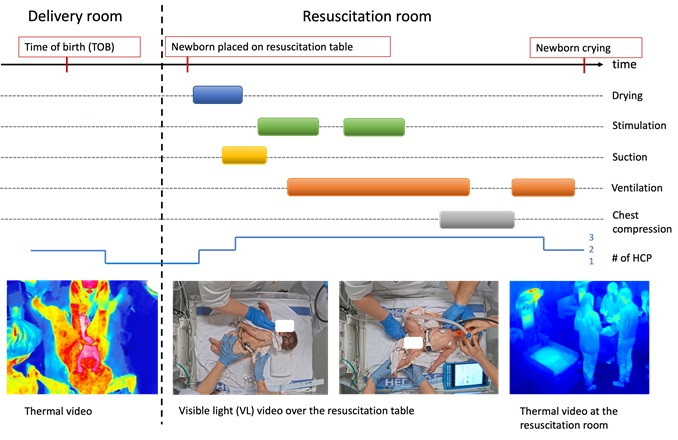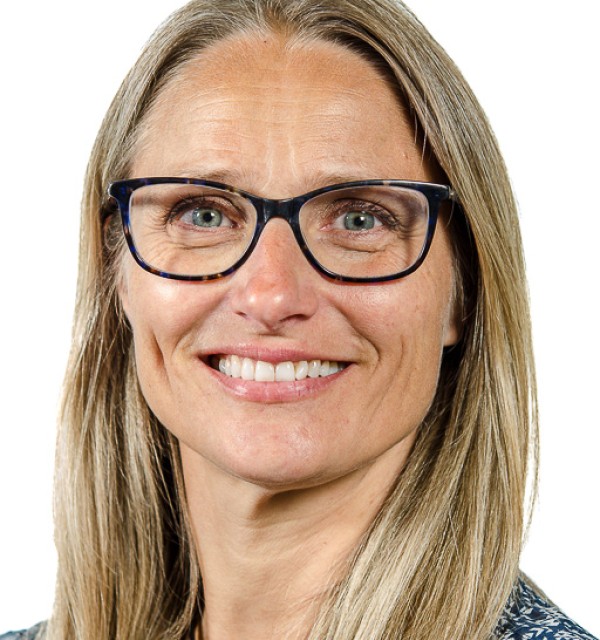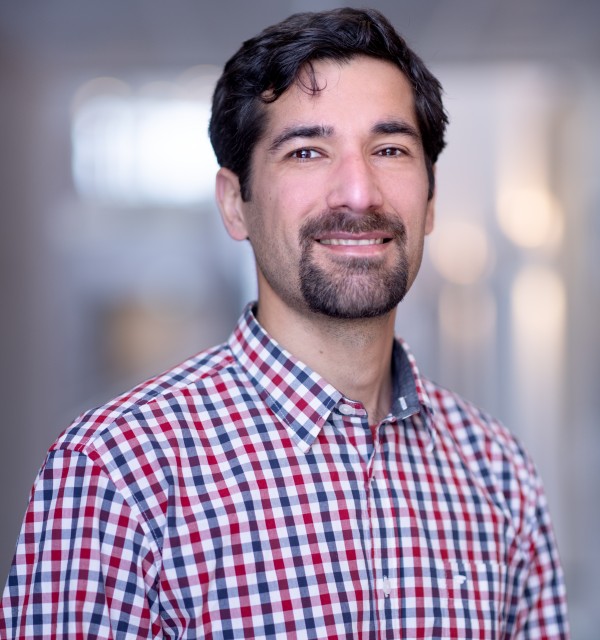The NewbornTime project addresses a critical need in global neonatal care: the optimization and timely delivery of resuscitation interventions for non-breathing newborns. As birth asphyxia remains a leading cause of neonatal mortality, timely and effective resuscitation is vital, ideally within the first “golden minute” post-birth.
NewbornTime’s central innovation is the development of an AI-based tool that automatically detects and timestamps key activities from birth and resuscitation using video footage, generating objective, second-accurate timelines. Through interdisciplinary collaboration between clinicians and health informatics experts, NewbornTime has built and tested a prototype capable of recognizing time of birth and resuscitation activities from thermal and visual light videos. This tool supports quality improvement, clinical training, and future research by providing structured, quantifiable data on care delivery. The project exemplifies impactful cooperation between academia, healthcare, and industry with the goal of enhancing outcomes for newborns globally, especially in resource-constrained settings. Ultimately, NewbornTime aims to contribute to data-guided debriefing, guideline adherence, reduce preventable deaths and long-term impairment, and inform evidence-based revisions to neonatal resuscitation protocols.
Underpinning research
NewbornTime builds on over a decade of collaborative research and innovation - from Helping Babies Breathe initiative in 2009 to Safer Births initiatives in Tanzania and Norway - continuing with Safer Births Scandinavia through 2030. It is grounded in a series of interdisciplinary studies that address the need for precise, data-driven analysis of newborn resuscitation efforts. Central to the project is the hypothesis that objective, second-precision timelines of birth and resuscitation activities, automatically generated from video and sensor data, can significantly improve clinical training, care quality, and outcomes for newborns.
The project has developed new ways to capture, understand, and analyze how healthcare workers respond in those first critical minutes after birth. Instead of relying on written notes or memory, NewbornTime uses thermal and visual light cameras and sensors to record what actually happens and then applies modern technology to analyze these recordings. One of the project’s key achievements is a method to turn these detailed video recordings into structured timelines. Each second of video is translated into a code that shows what kind of treatment is being given to help the baby breathe. This method allows researchers to create a complete picture of the sequence and timing of care given to each newborn [1]. By applying mathematical tools to these timelines, researchers have found clear patterns that are linked with whether babies recover well, need extra care, or unfortunately do not survive. This kind of insight is rarely possible with traditional documentation, which usually lacks precise timing.
The timelines are generated using deep learning based Artificial Intelligence models for activity recognition from video. The AI model for resuscitation activity recognition was trained on over 220 visual light video recordings from resuscitation and has shown high accuracy in recognizing key actions like providing ventilation or stimulation. Unlike earlier systems that required complicated steps like detecting individual objects or tracking hand movements, this approach can work directly with regular video frames, which makes it easier and faster to use in real settings [2].
A particularly valuable part of the project is its ability to connect these timelines to the exact moment a baby is born. This makes it possible to measure whether treatment starts within the recommended golden minute, which is known to be critical for survival and long-term health. In clinical settings today, time of birth is usually recorded manually only to the nearest minute, which makes it difficult to know if care started quickly enough [3]. NewbornTime solves this problem by using thermal video from the delivery room together with specially developed AI models that can automatically and precisely mark the time of birth [4,5,6].

In the previous Safer Births project, the consortium has also explored how other types of data, like heart rate signals and movement sensors, can help detect when a baby is being stimulated or ventilated. This is especially helpful in situations where the camera view is blocked or unclear. Studies have shown that combining these different data sources improves the reliability of detecting what actually happened during resuscitation [7]. Another important aspect for transferability of the developed tools is that some of the tools have been tested in both a modern hospital in Norway and a rural hospital in Tanzania, which shows that the ideas and methods are flexible and can be adapted to different environments The research team has also carefully documented the ethical steps taken to ensure privacy and informed consent, which is especially important when working with video recordings of newborns and clinical staff [8].
References to the research
[1] Abukmeil, M., Meinich-Bache, Ø., Eftestøl, T., Rettedal, S., Myklebust, H., Tysland, T.B., Ersdal, H., Mduma, E., Engan, K., 2024. Analysis and knowledge extraction of newborn resuscitation activities from annotation files. BMC Med Informatics and Decision Making 24, 327. https://doi.org/10.1186/s12911-024-02736-4
[2] Rizvi, S.T.H., Meinich-Bache, Ø., Kolstad, V., Rettedal, S., Brunner, S., Engan, K., 2024. Semi-Supervised Action Recognition from Newborn Resuscitation Videos, in: 2024 IEEE International Conference on Image Processing (ICIP). Presented at the 2024 IEEE International Conference on Image Processing (ICIP), pp. 2347–2353. https://doi.org/10.1109/ICIP51287.2024.10648001
[3] Kolstad, Vilde, Jorge García-Torres, Sara Brunner, Anders Johannessen, Elizabeth Foglia, Hege Ersdal, Øyvind Meinich-Bache, and Siren Rettedal. 2024. “Detection of Time of Birth and Cord Clamping Using Thermal Video in the Delivery Room.” Frontiers in Pediatrics 12 (August). https://doi.org/10.3389/fped.2024.1342415
[4] Garcia-Torres, Jorge, Oyvind Meinich-Bache, Sara Brunner, Anders Johannessen, Siren Rettedal, and Kjersti Engan. “Towards Using Thermal Cameras in Birth Detection.” In 2022 IEEE 14th Image, Video, and Multidimensional Signal Processing Workshop (IVMSP), 1–5. Nafplio, Greece: IEEE, 2022. https://doi.org/10.1109/IVMSP54334.2022.9816177.
[5] J. García-Torres, Ø. Meinich-Bache, A. Johannessen, S. Rettedal, V. Kolstad, and K. Engan, “Advancing newborn care: Precise time of birth detection using ai-driven thermal imaging with adaptive normalization,” Computers in Biology and Medicine, vol. 187, p. 109726, Mar. 2025, doi: 10.1016/j.compbiomed.2025.109726.
[6] J. García-Torres, Ø. Meinich-Bache, S. Rettedal, and K. Engan, “AI-Based Thermal Video Analysis in Privacy-Preserving Healthcare: A Case Study on Detecting Time of Birth,” Proc. Of ISBI 2025, arXiv: arXiv:2502.04365. doi: 10.48550/arXiv.2502.04365.
[7] J. Urdal et al., “Automatic prediction of therapeutic activities during newborn resuscitation combining video and signal data,” Biomedical Signal Processing and Control, vol. 86, p. 105290, Sep. 2023, doi: 10.1016/j.bspc.2023.105290.
[8] Engan, Kjersti, Øyvind Meinich-Bache, Sara Brunner, Helge Myklebust, Chunming Rong, Jorge García-Torres, Hege L. Ersdal, Anders Johannessen, Hanne Markhus Pike, and Siren Rettedal. “Newborn Time - Improved Newborn Care Based on Video and Artificial Intelligence - Study Protocol.” BMC Digital Health 1, no. 1 (March 8, 2023): 10. https://doi.org/10.1186/s44247-023-00010-7.
Details of the impact
The NewbornTime project, along with the Safer Births projects it builds on, is already producing tangible impacts in clinical care, education, research, and technology development, particularly in how healthcare teams understand and respond to newborns requiring resuscitation [A, B]. Although not yet implemented in routine practice, the project has demonstrated potential to change how neonatal resuscitation is documented, analyzed, debriefed and improved.
At the clinical level, the project addresses one of the most time-critical challenges in neonatal care: ensuring that breathing support is initiated within the first minute after birth. Traditionally, however, documentation of care during this crucial window has relied on memory or imprecise notes. NewbornTime introduces an automated way of generating second-by-second timelines using video and sensor data. Clinical staff involved in the project have reflected on the benefit of being able to visualize these timelines to better understand and optimize their performance during high-pressure situations. The impact is particularly evident in efforts to improve response time. Healthcare professionals have noted that although teams are generally good at initiating support, there is still room for improvement in acting faster. One nurse emphasized that, during resuscitations, what needs to be done should be “simple and straightforward” [C], reflecting the need for systems that support quick decision-making and action. By providing objective data on exactly when and how interventions are initiated, NewbornTime creates new opportunities to identify bottlenecks, improve routines, and ultimately save lives in those first critical minutes.
Beyond individual cases, the tool has strong potential for structured team debriefing and training. Through visual playback and data-driven summaries, teams can engage in reflective learning, comparing their actions with recommended protocols. This is particularly useful in clinical education, where learning from real events is essential but often limited by a lack of reliable data. Senior neonatologists involved in the project see the tool as a foundation for continuous quality improvement [D], allowing staff to not only treat patients but also reflect and learn from each case.
The project’s structure has also fostered an unusually effective collaboration between hospital clinicians, academic researchers, and industry developers. Each partner brings complementary expertise - clinical insight, data science, and product development - that together enable innovation not possible within a single sector. As one project participant put it, the project benefits from “a triangle of truly competent people” working across institutional boundaries [E]. This collaboration has been essential to translating clinical needs into technical solutions and ensuring that those solutions are grounded in real-world practice.
NewbornTime is also contributing to scientific advancement in data collection and artificial intelligence. A major barrier to learning from newborn resuscitation is the difficulty of collecting consistent, high-quality data. Manual data collection is labor-intensive and often incomplete. By automating the process of identifying and labeling clinical activities from video, NewbornTime dramatically reduces the human resources required to gather large datasets. This scalability opens the door for broader studies that can answer critical questions, such as which patterns of care are most effective and how guidelines might be revised based on real-world evidence.
The project's work on artificial intelligence also contributes to broader technological impact. The development of algorithms that can analyze video from clinical settings is a big step forward for AI in healthcare. These systems have the potential to support documentation, improve training, and even assist clinical decision-making in real time. Researchers involved in the project emphasized that these tools, while designed for neonatal care, could also be adapted for other medical applications [F].
Ethical and practical concerns around data privacy have also shaped the project’s design. By focusing on systems that allow data to be processed locally, i.e. in the delivery room or hospital system, NewbornTime supports the development of decentralized AI models that do not require transferring sensitive video files to external servers [G]. This aligns with emerging requirements in clinical data governance and positions the project to meet future legal and ethical standards.
Importantly, even if the NewbornTime system has been piloted in a high-resource setting in Norway, the ideas for the project came from long-time collaboration in Safer Births studies from Tanzania – a low-to-medium income country reinforcing its flexibility. This global perspective ensures that the tools can be relevant not just in technologically advanced hospitals, but also in settings where neonatal mortality is highest. The ability to standardize data collection and feedback across different contexts is a powerful step toward improving equity in newborn care.
Sources to corroborate the impact
[A] NewbornTime Homepage
[C] Mette Skretting, Pediatrician and Research Assistant, Stavanger University Hospital
[D] Siren Rettedal, Neonatal Specialist, Stavanger University Hospital
[E] Sara Brunner, R&D Senior Scientist, Lærdal Medical
[F] Kjersti Engan, PI, Professor in information technology, University of Stavanger
[G] Chunming Rong, Professor of Informatics/Computer Engineering, UiS and CEO, BitUnitor
Contact
Department of Electrical Engineering and Computer Science
Department of Innovation and External Collaboration

